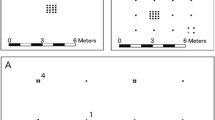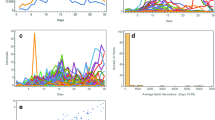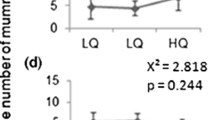Abstract
Ideal free distribution (IFD) models are perhaps the group of mathematical models of behavior that have been the most widely and successfully applied by empiricists. These models can be applied to nearly any situation in which consumers compete—by any mechanism—for resources that are patchily distributed in their environment. Although IFD models have come to be broadly accepted, experiments that simultaneously test more than a single prediction are rare. Instead, investigators normally either test (1) for a relationship between the distribution of consumers and the distribution of resources or (2) whether average fitnesses are equal across resource patches. We conducted experiments with pea aphids (Acyrthosiphon pisum Harris) feeding on two patches of fava beans (Vicia faba L.) to fully independently parameterize an IFD model with interference competition and then test quantitative predictions about aphid spatial distributions and the payoffs of patch choice. We found a precise fit between aphids’ predicted and observed reproductive successes. Furthermore, by varying patch “quality” in two ways, we were able to show that aphid distributions vary with the mode of resource variation in the predicted manner: aphids (1) matched resources when patches varied in size but not quality and (2) overmatched the good patch when patches varied in quality but not size (predicted as a consequence of weak interference). The close correspondence between quantitative predictions of the model with observed behaviors suggests that IFD theory is a framework with more explanatory power than is generally appreciated.




Similar content being viewed by others
References
Alonzo SH (2002) State-dependent habitat selection games between predators and prey: the importance of behavioural interactions and expected lifetime reproductive success. Evol Ecol Res 4:759–778
Bernstein C, Kacelnik A, Krebs JR (1988) Individual decisions and the distribution of predators in a patchy environment. J Anim Ecol 57:1007–1026
Bernstein C, Kacelnik A, Krebs JR (1991) Individual decisions and the distribution of predators in a patchy environment. 2. The influence of travel costs and structure of the environment. J Anim Ecol 60:205–225
Campbell A, Mackauer M (1975) Thermal constants for development of the pea aphid (Homoptera: Aphididae) and some of its parasites. Can Entomol 107:419–423
Cosner C (2005) A dynamic model for the ideal-free distribution as a partial differential equation. Theor Popul Biol 67:101–108
Cressman R, Křivan V, Garay J (2004) Ideal free distributions, evolutionary games, and population dynamics in multiple-species environments. Am Nat 164:473–489
Cresswell W, Smith RD, Ruxton GD (2001) Absolute foraging rate and susceptibility to interference competition in blackbirds varies with patch conditions. J Anim Ecol 70:228–236
Dolman PM (1995) The intensity of interference varies with resource density: evidence from a field study with snow buntings, Plectrophenax nivalis. Oecologia 102:511–514
Dolman PM, Sutherland WJ (1997) Spatial patterns of depletion imposed by foraging vertebrates: theory, review and meta-analysis. J Anim Ecol 66:481–494
Douglas AE (2003) The nutritional physiology of aphids. Adv Insect Physiol 31:73–140
Earn DJD, Johnstone RA (1997) A systematic error in tests of ideal free theory. P Roy Soc Lond B Bio 264:1671–1675
Flaxman SM (2006) Ideal free distribution models of habitat selection behavior: review, synthesis, and empirical tests. PhD dissertation, Cornell University, Ithaca, NY
Fretwell SD, Lucas HL Jr (1970) On territorial behavior and other factors influencing habitat distribution in birds. Acta Biotheor 19:16–36
Grand TC (2002) Alternative forms of competition and predation dramatically affect habitat selection under foraging–predation-risk trade-offs. Behav Ecol 13:280–290
Grand TC, Dill LM (1999) Predation risk, unequal competitors and the ideal free distribution. Evol Ecol Res 1:389–409
Gray RD, Kennedy M (1994) Misconceptions or misreadings? Missing the real issues about the IFD. Oikos 71:167–170
Hale BK, Bale JS, Pritchard J, Masters GJ, Brown VK (2003) Effects of host plant drought stress on the performance of the bird cherry-oat aphid, Rhopalosiphum padi (L.): a mechanistic analysis. Ecol Entomol 28:666–677
Hassell MP, Varley GC (1969) New inductive population model for insect parasites and its bearing on biological control. Nature 223:1133–1136
Holmgren N (1995) The ideal free distribution of unequal competitors: predictions from a behaviour-based functional response. J Anim Ecol 64:197–212
Huberty AF, Denno RF (2004) Plant water stress and its consequences for herbivorous insects: a new synthesis. Ecology 85:1383–1398
Hugie DM, Grand TC (1998) Movement between patches, unequal competitors and the ideal free distribution. Evol Ecol 12:1–19
Hugie DM, Grand TC (2003) Movement between habitats by unequal competitors: effects of finite population size on ideal free distributions. Evol Ecol Res 5:131–153
Humphries S, Ruxton GD, van der Meer J (2001) Unequal competitor ideal free distributions: predictions for differential effects of interference between habitats. J Anim Ecol 70:1062–1069
Jackson AL, Humphries S, Ruxton GD (2004a) Resolving the departures of observed results from the ideal free distribution with simple random movements. J Anim Ecol 4:612–622
Jackson AL, Ranta E, Lundberg P, Kaitala V, Ruxton GD (2004b) Consumer–resource matching in a food chain when both predators and prey are free to move. Oikos 106:445–450
Jansson J, Ekbom B (2002) The effect of different plant nutrient regimes on the aphid Macrosiphum euphorbiae growing on petunia. Entomol Exp Appl 104:109–116
Kennedy M, Gray RD (1993) Can ecological theory predict the distribution of foraging animals? A critical analysis of experiments on the ideal free distribution. Oikos 68:158–166
Lessells CM (1995) Putting resource dynamics into continuous input ideal free distribution models. Anim Behav 49:487–494
Losey JE, Denno RF (1998) Positive predator–predator interactions: enhanced predation rates and synergistic suppression of aphid populations. Ecology 79:2143–2152
Milinski M (1994) Ideal free theory predicts more than only input matching—a critique of Kennedy and Gray’s review. Oikos 71:163–166
Moody AL, Ruxton GD (1996) The intensity of interference varies with food density: support for behaviour-based models of interference. Oecologia 108:446–449
Morris DW (2003) How can we apply theories of habitat selection to wildlife conservation and management? Wildlife Res 30:303–319
Neter J, Kutner MH, Nachtsheim CJ, Wasserman W (1996) Applied linear statistical models, 4th edn. Irwin, Chicago
Parker GA (1978) Searching for mates. In: Krebs JR, Davies NB (eds) Behavioural ecology: an evolutionary approach. Sinauer Associates, Sunderland, pp 214–244
Parker GA, Sutherland, WJ (1986) Ideal free distributions when individuals differ in competitive ability – phenotype-limited ideal free models. Anim Behav 34:1222–1242
Rice WR (1989) Analyzing tables of statistical tests. Evolution 43:223–225
Ruxton GD, Moody AL (1997) The ideal free distribution with kleptoparasitism. J Theor Biol 186:449–458
Sih A (1998) Game theory and predator–prey response races. In: Dugatkin LA, Reeve HK (eds) Game theory and animal behavior. Oxford University Press, New York, pp 221–238
Sutherland WJ (1983) Aggregation and the “ideal free” distribution. J Anim Ecol 52:821–828
Sutherland WJ (1992) Game-theory models of functional and aggregative responses. Oecologia 90:150–152
Sutherland WJ, Allport GA (1994) A spatial depletion model of the interaction between bean geese and wigeon with the consequences for habitat management. J Anim Ecol 63:51–59
Sutherland WJ, Dolman PM (1994) Combining behaviour and population dynamics with applications for predicting consequences of habitat loss. P Roy Soc Lond B Bio 255:133–138
Sutherland WJ, Parker GA (1985) Distribution of unequal competitors. In: Sibly RM, Smith RH (eds) Behavioural ecology: ecological consequences of adaptive behaviour: the 25th symposium of the British ecological society, Reading 1984. Blackwell Scientific, Oxford, pp 255–273
Sutherland WJ, Parker GA (1992) The relationship between continuous input and interference models of ideal free distributions with unequal competitors. Anim Behav 44:345–355
Tregenza T (1995) Building on the ideal free distribution. Adv Ecol Res 26:253–307
Tregenza T, Parker GA, Thompson DJ (1996a) Interference and the ideal free distribution: models and tests. Behav Ecol 7:379–386
Tregenza T, Parker GA, Thompson DJ (1996b) Interference and the ideal free distribution: oviposition in a parasitoid wasp. Behav Ecol 7:387–394
van der Meer J (1997) The ideal free distribution when predators differ in competitive abilities. Oikos 80:301–310
van der Meer J, Ens BJ (1997) Models of interference and their consequences for the spatial distribution of ideal and free predators. J Anim Ecol 66:846–858
Acknowledgment
This work was supported by a grant from the Department of Neurobiology and Behavior and SMF was supported during part of this research by a National Science Foundation Graduate Research Fellowship. We thank R. J. Safran for help with statistical analyses. T. Barback and K. Bullerdick provided invaluable assistance with data collection in 2004. R. Fathke and H. Cringan both provided help with the maintenance of organisms in the laboratory. We thank H. K. Reeve and R. J. Safran for many discussions about these ideas. Members of the Neurobiology and Behavior Lunch Bunch provided valuable critical feedback. H. K. Reeve, P. W. Sherman, J. L. Losey, C. Gilbert, R. Booker, and R. J. Safran all provided helpful criticisms on preliminary drafts. Suggestions from W. Blanckenhorn and an anonymous reviewer significantly improved this manuscript. All experiments performed comply with the laws of the USA.
Author information
Authors and Affiliations
Corresponding author
Additional information
Communicated by H. Kokko
Rights and permissions
About this article
Cite this article
Flaxman, S.M., deRoos, C.A. Different modes of resource variation provide a critical test of ideal free distribution models. Behav Ecol Sociobiol 61, 877–886 (2007). https://doi.org/10.1007/s00265-006-0316-8
Received:
Revised:
Accepted:
Published:
Issue Date:
DOI: https://doi.org/10.1007/s00265-006-0316-8




